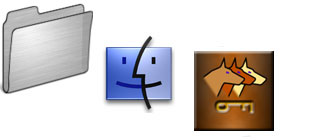 ![[Header]](../XuShared2/Line3.jpeg)

(Up to OJB's Mac Tips List Page)
Finding FilesThe Find File program available in System 7.5 is nice for two reasons. One, it is a useful fast, flexible utility for searching for apparently lost files. And two, it demonstrates some cool drag-and-drop behavour. I really wish more apps supported drag-and-drop to this extent! In this article I am going to describe some of the more obscure functions available in this utility.
System 7.5 has a new program to Find files instead of just the Find command built into the Finder. By default the Finder's Find command launches this program instead of using the old built-in find.
Hold down the shift key when using the Find command (from menu or keyboard) to use the Finder's old find function instead of the new Find File program. Do the same to use the old Find next command. To permanently stop the new Find File launching from the Finder throw away the Find File extension in the extensions folder.
Find command is a separate application so it processes separately from the Finder, in other words you can use the Finder for other functions like copying and launching while the find is being processed. You can even make multiple Find File programs and run several searches simultaneously. You can also run the old Find command and the new Find simultaneously.
Just Drag and Drop
If you need a list of files that Find File has found you can copy the list created into a word processor or text editor program. Just use Select All to select all the found files, Copy them, then Paste them into the program. If your program supports drag and drop (if you use Word Perfect it does, if you use Word bad luck sucker) you can drag the files instead and get a more complete report. A technical report with type and creator, modification date etc is available by holding down the Option key while you drag the items.
Note: don't drag the files onto the desktop and expect to get a clipping file like you might expect. The actual original files get dragged instead. This can be useful but don't get it confused with dragging to a text program. If you Command-Drag an item you create an alias to it in the location you drag to.
Clicking in one of the headings in the list (name, size, kind, modified) sorts by that attribute. Option-clicking sorts in reverse order. Now why doesn't the Finder do that too!
You can make complex searches by clicking More Choices (or using Command-M) and reduce the complexity by using Fewer Choices (Command-R). If you want to remove a part of a complex search between other parts you want to keep just Option-drag that line to the Trash.
Searching on Files' contents
Most Find File searches look at the title, date created, etc of the file and never look at the actual contents of the file. If you want to look for something in a file you can do that too. Hold down the Option key when you click in the first pop-up list when specifying a search. Choose the extra option "content" (note 3 other new items as well). This search actually opens all the files in the location being searched and looks inside them for what you specify. There are some warnings though. First, the search will be slow. Looking in the file involves much more work than just looking at the name. Second Find File just treats the file as text and can't understand formatting so the search may not be successful if the text beinf searched contains formatting information. Find File deliberatle ignores some types of files which don't generally contain searchable text such as applications.
Option click Stop when a search is in progress to go immediately to the list of items found so far instead of being asked if this is what you want to do.
Sherlock
With Mac OS 8 and 9 Find File has become obsolete because Sherlock has now been included with the System. Big advantages of Sherlock include built-in Internet searching with relevance ranking of results, and fast content searching.
Content searches allow finding text in the actual content of the file, not just in its name. Content searches require the disk containing the documents being searched to be indexed. Indexing a disk can take many hours so you should set up a schedule in Sherlock to index your files when the computer isn't being used, for example at midnight each night. Once the index is created content searches take just a few seconds.
![[Up]](../XuShared/Up2B.jpeg)
|

![[Up]](../XuShared/Up2B.jpeg)